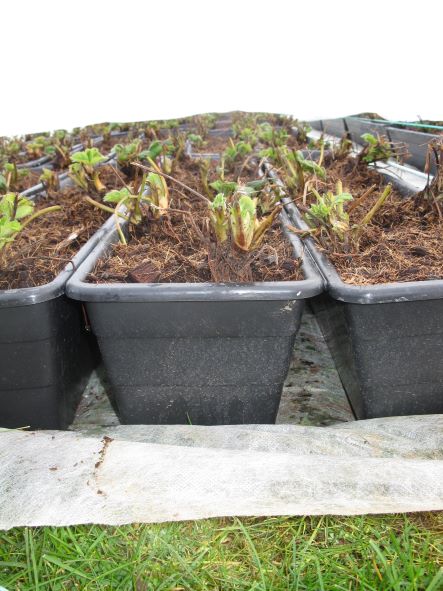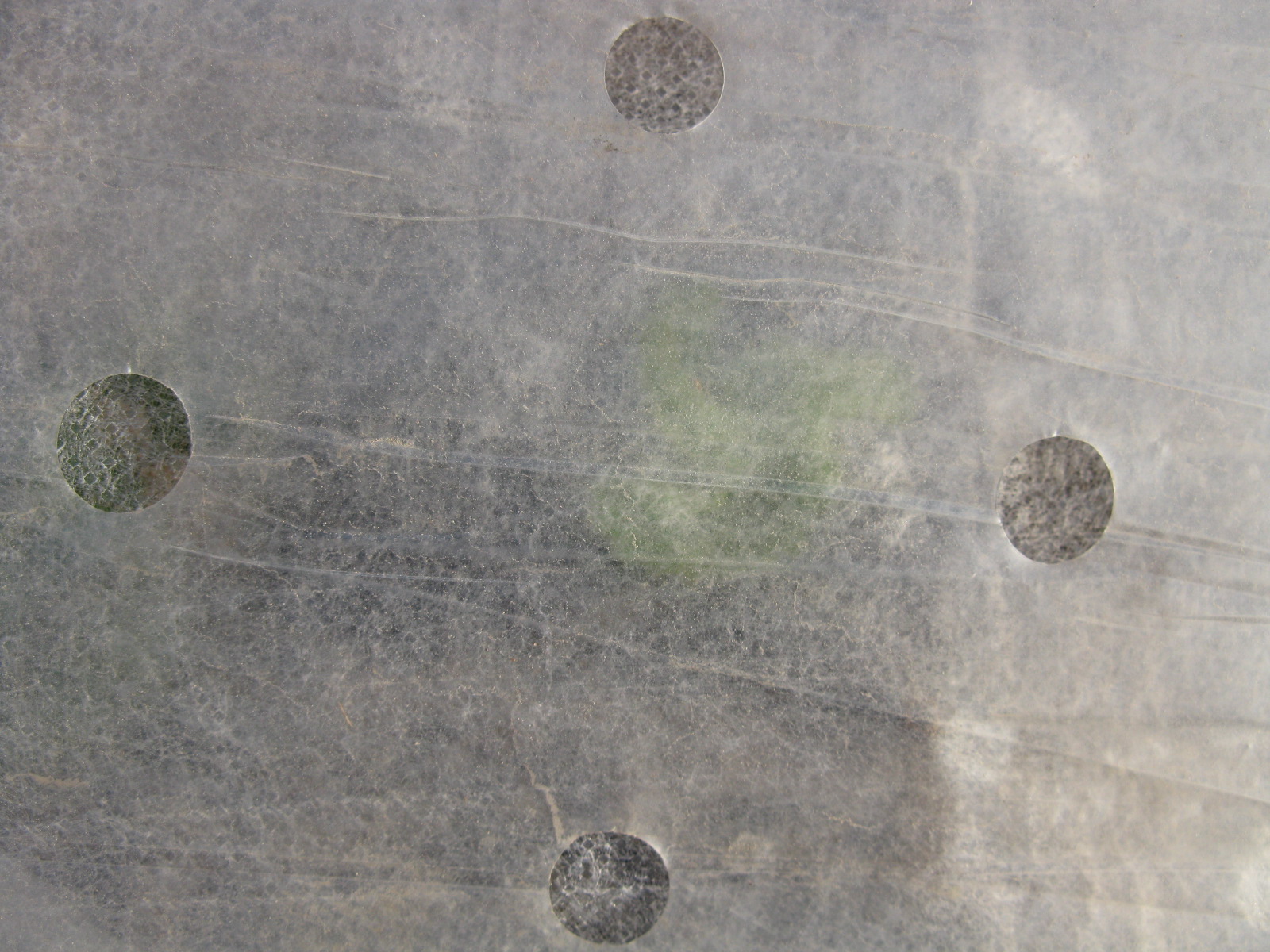Please click here to access the main AHDB website and other sectors.
- Home
- Knowledge library
- Strawberry cold injury: providing protection
Strawberry cold injury: providing protection
Learn about practical measures that can be used to minimise cold injury.
Practical protection options
Action points
- Move crops into a permanent structure with heating capability for frost protection, although this is not practical for many growers.
- Move crops into a permanent unheated structure which is strong enough to survive winter weather conditions.
- Place tabletop crops on the ground, wrapped in fleece.
- Leave tabletop crops raised but wrapped in fleece.
This list was compiled in order of reliability at protecting the crop.
Moving and wrapping crops incurs significant labour costs. You may not be able to achieve the best protection for all crops, so priorities should be set.
Best practice for ground-located troughs and bags
Decide on the over wintering height. This is a significant protection factor. Some systems are almost ground based, e.g. on draining mats or raised wires. These are sufficiently close to the ground to benefit from the daytime heat reserves and minimal wind chilling and do not need to be moved.
Tabletop crops are always best lowered to the ground for these reasons, though this may not be an economic possibility for all farms.
Place troughs and bags onto free draining ground. Waterlogged compost freezes around the roots and is more likely to result in cold injury than drier compost.
Pest and disease
Fleeced crops can stay wet for longer. Several weeks of soggy foliage will develop Botrytis. This disease will slowly rot the tops of the crowns.
Keep checking for this on a weekly basis and remove the covers to allow drying out if this becomes apparent.
Ensure the canopy is free of pests before covering. Fleecing of a crop provides protection from the cold but will encourage pest development in mild spells. A high-volume crown penetrating spray of chlorpyrifos or lambda-cyhalothrin is temperature insensitive and will kill aphids and caterpillars.
You may consider adding a Botryticide and slug protection.
Control weeds
Control grass and weed growth around the crop. A fleeced and sheltered area will encourage weed growth through winter. Place a permeable membrane between the ground and the crop. A layer of fleece or woven polypropylene is sufficient as the closely placed bags also suppress weed growth.
Troughs
Placing troughs side by side can help reduce cold edges and reduce the likelihood of cold damage. See figure 1.

Figure 1. Place troughs side by side to reduce cold edges
Wind injury
Reducing the surface area of bags and troughs exposed to the wind will reduce potential injury. Positioning bags and troughs side by side will achieve this and containing them within a perimeter of straw bales or bunched fleece/polythene will further help to reduce the edge effect of wind chilling.
Consider placing a polythene sidewall down a windward edge, remembering that cold air also needs to drain away.
Prepare for cold weather
Prepare for prompt action when the medium range weather forecasts predict a spell of cold weather. The time required to cover can be minimised with advance preparation.
Protect from rain
Lay the fleece and/or polythene mulch along the alleys ahead of winter and prepare a method of anchoring the covers (e.g. bags of soil). Keep rain off the fleece. Preceding cold, wet conditions can create unmanageable frozen or soggy fleece at covering.
Trials have shown that two layers of fleece give slightly better protection than a single layer of double density fleece. They simply trap more air for insulation. If possible, avoid using dirty, weed seed infested fleece.
Vermin
Watch out for vermin during winter. Rabbits may never have been a problem for tabletop sites but will now be within reach.
Drought risk
Consider the need for water access. Drought can be a risk in some winters, though plants are able to tolerate several weeks in relatively cold dry compost, just as commercially cold stored tray plants do.
Typical British winters tend to have wet spells and the risk of desiccation is low unless there is much growth under the fleece. Holed polythene covers would be more difficult to penetrate with overhead irrigation, if drought was encountered.
Best practice for tabletop-located crops
The same principles apply for tabletop protection.
Tabletops are significantly exposed to wind run and experience more rapid freezing.
A double layer of fleece is most important as the extra layers simply trap more air into the protective layer. See figure 2.
 RSK ADAS
RSK ADAS
Figure 2. Holed polythene ‘lay flat’ over single thickness fleece gives good temperature and wind protection
Wrapping loosely bunched fleece over the top and sides of bags with an outer layer of permeable polythene would enclose an air volume with the greatest insulation.
However, should the season dictate, be aware that such protection is hard to remove and reinstate when compared to ground-located crops.
Fleece protection
Avoid covering too soon, or soft growth may occur.
Covering is likely to be required in late October at the earliest.
It would be possible to partially slash the fleece protection rather than remove it if there is an unexpected mild spell.
Dormancy
Remember that tabletop crops can survive freezing, though the increased exposure to wind is a serious threat.
Bear in mind that complete frost protection is not desirable, as cold is needed to maintain dormancy.
Strawberries are a hardy perennial and capable of surviving most British winters unaided.
Timing of covering
Encourage full dormancy
- Allow the crop to harden off before covering as soft tissue is the most easily damaged.
- Dormancy is reached around the beginning of November at the earliest; several normal frosts will be an advantage to harden the crowns before protection is put in place.
- Use of a max-min thermometer between the bags in the lowest most frost prone area will provide a better insight.
- Short frosts of around -5°C are not harmful.
Avoid breaking dormancy
- British winters can turn mild, and covered crops begin to grow if not monitored frequently.
- Inspect crowns regularly through the winter.
- Dormant plants have the best physiological defence against cold damage.
- Crowns can also rot with Botrytis when exposed to prolonged damp conditions under fleece.
- As soon as the weather becomes milder, remove one layer but leave a single fleece for longer if needed.
- Winter protection should never be allowed to accidentally advance crop development in spring.
- It is likely that any serious prolonged cold risks are over by mid-February.
Types of cover
- Covering reduces the rate of heat transfer; it slows the rate of freezing.
- Prolonged freezing conditions ultimately chill through all defences.
- A single layer of fleece will protect strawberry plantings from several degrees Celsius of frost.
- Loose straw is an unlikely option for British crops as it is slow to apply and remove.
- It will also hasten crown rotting if there is a lot of cold wet weather.
Original author
Robert Irving, ADAS

